Photo: Paul Rudderow
Following last week’s discussion of the merits of the 4-3-3, PSP’s Eli Pearlman-Storch outlines the traditional 4–4–2 as it would work for the Union in 2012 in the second of a three-part series.
With the continuing turnover in the roster, the 2012 Philadelphia Union must find consistency on the pitch in order to prove that last year’s playoff appearance was no fluke. While the defense appears to again be the strength of a team that was MLS’s second stingiest in conceding goals during the 2011 campaign, the offense must come out of the gates scoring goals if they are to keep up with a vastly improved Eastern Conference. Consistency and chemistry are immediate needs for such a young club and opening up in a straight 4–4–2 would eliminate confusion, provide depth at all positions, and allow players to develop strong relationships all over the pitch.
4–4–2 for 2012
While many coaches give new acquisitions time to work their way into the lineup, whether out of necessity or inclination, Peter Nowak is no such manager. In 2011’s opening match, a 1–0 road victory in Houston, new signings Faryd Mondragon, Carlos Valdes, Brian Carroll and Carlos Ruiz all featured prominently and immediately for the Union. In 2012, three new signings will likely debut when they walk out in the starting lineup in Portland on March 12, Porfirio Lopez, Josue Martinez and Lionard Pajoy. And while this does represent another year of significant personnel change, each of these players fits smartly into an aggressive 4–4–2.
News that both Freddy Adu and Roger Torres would be returning in 2012 means that the Union must find a space for at least one of them on the pitch at any moment as both have the ability to run the offense from the center of midfield. With Brian Carroll installed as the incumbent holding midfielder, and the most defensive minded of the Union’s central midfield options, whether it is Adu or Torres roaming the center of the park, they will have the freedom they need to display their creativity and set the table for those around them. As with last week’s 4–3–3, Adu will earn the start because, simply put, he’s the biggest name with the biggest contract. And there is nothing cynical meant by that selection. At this juncture in the Union’s brief history, Freddy Adu represents the Union’s most experienced MLS attacker. It was not long ago that all of Philadelphia, myself included, was clamoring for the Union to acquire a highly rated CAM (central attacking midfielder). After time playing that role with the US U-23 National Team, and a full preseason with the Union, the beginning of the 2012 MLS season represents the best chance for a now 100 percent healthy Adu to prove that he is ready, willing and able to lead the Union attack, whether it is with his own piercing runs, or more preferably as the distributor whose vision and savvy allow him to create opportunities for the dangerous wingers and to play his strikers in on net.
The best right side in MLS
There’s no denying the fact that Sheanon Williams and Michael Farfan were two of the biggest surprises around MLS in 2011. While Williams entered the year following some stout defensive showings at the end of 2010, his rapid ascension into one of the most dangerous attacking fullbacks in MLS caught many by surprise, as he forced his way into the US National Team conversation with his searing pace, attacking mindset and continually maturing defensive understanding. His partnership with Carlos Valdes on the right side of the Union defense was simply impenetrable at times as Williams pressed high up the pitch, pinning back opposing wingers, and forcing opposition attacks to build down the Union’s left flank.
Michael Farfan responded to sliding out of the first round in the 2011 MLS SuperDraft by growing and improving all year. He not only forced himself into the Union starting XI but also into Rookie of the Year discussions league-wide. His on the ball guile, mixed with excellent field vision, made him a prime candidate to beat any defender one-on-one before providing service into the box or taking a shot himself.
As a unit, Willams and Farfan brought the whole package to the table and they are one piece of the Union formation that must remain in tact. There are no struggles for chemistry between these two as Farfan quickly learned the virtues of having a constant partner in crime with Williams rampaging up the wing, ready to receive the ball or provide the decoy necessary for Farfan to deceive his defender and break into the box. Additionally, with the Union’s lack of defensive depth in 2011, Farfan was as times forced into a defensive role in which, while he did not excel all the time, he learned a greater appreciation for his own defensive responsibilities when Williams went on one of his trademark runs downfield.
The Costa Rican Connection
Costa Rican internationals Josue Martinez and Porfirio Lopez, both of whom have been capped for their full National team, have the speed, ability and experience to form a similar partnership on the Union’s left flank. While there are plenty of others who can play the left midfield position, including Keon Daniel, Gabriel Farfan, and new signing Nizar Khalfan, Martinez is another big money signing with an excellent attacking pedigree who should see plenty of minutes in 2012. When he was signed in December, Peter Nowak made it clear that, “he can play as a central striker or on the wing, we can mix it up. We can be very unpredictable with his skill set and that’s a very important factor to our game.” With more balanced service needed from both sides of the pitch, Martinez could prove extremely valuable out wide and his rapid acclimation into MLS will be a determining factor for how long it takes for the Union to get up to speed, regardless of what position the coaching staff asks him to adopt.
Playing in front of an established, naturally left-footed fullback like Lopez will help the young attacker, as Lopez, whose career took him briefly to the Chinese league in 2010-11, will look to provide the Union back four with the consistency it lost when Jordan Harvey made the move to Vancouver. Gabriel Farfan deserves credit for his work in the role that was surprisingly thrust upon him, but with a true left back now on the roster, Lopez can develop the relationship with captain Danny Califf that Williams and Valdes share on the other side of the pitch, hopefully turning a stingy defense into an unsolvable one.
While the projected play of both Martinez and Lopez remains largely conjecture until the season is off and running, Nowak recently stressed that while Martinez has featured at forward in the preseason, “He can come from the second line because of his speed. We can use him in different fashions.” Nowak is no stranger to converting players and if Martinez grew into the role, he could became a fixture opposite Michael Farfan.
Big Men up Front
What good is service into the box without big, strong strikers who can turn chances into goals? In Lionard Pajoy and Danny Mwanga, the Union have two such strikers. With Lajoy as the more veteran target man, Mwanga will get to play in his preferred role, as the second striker, allowed to face goal and run off his partner’s knock downs and hold-up play, firing shots and creating havoc all over the area.
That is not to say that in 2012 far more will not be expected of Mwanga when it comes to throwing his body around and winning a significantly larger number of aerial challenges than in past seasons—that is the requisite and logical next step in his development. With the physicality, pace and predatory instincts of both Pajoy and Mwanga on the pitch, the Union will create enormous matchup problems for any defense. As much as any team would want to put a second body on both of the Union’s big, versatile strikers, the threat of Martinez and Farfan joined by Lopez and Williams, respectively, coming from wide positions is too great. Any chance that either striker finds themselves in a mano a mano situation, the Union have won and they must capitalize. With Freddy Adu or Roger Torres pulling the strings from the midfield and occupying the full attentions of a defensive midfielder, the Union’s ability to attack in numbers creates mismatches and holes all over the pitch.
After that it is down to converting those chances, because with five players all looking to get in behind the defense, cracks will inevitably emerge. While not in the starting lineup, Jack McInerney’s strong offseason and improved play make him the first attacking weapon off the bench, allowing the Union to sit Pajoy should they want to get quicker and more dangerous on the ground, or Mwanga, if Pajoy’s back-to-goal play is proving fruitful and needs only a poacher’s touch to find the back of the net.
Substitutions
A deep roster means plenty of choices and regardless of what alterations the Union coaching staff must make during match play, they have options. Should they be in need of a goal to break a deadlock or become a comeback, see Figure 2. Replacing the spine of the team with quicker players allows the Union to possess and hold the ball higher up the park. Amobi Okugo provides improved distribution to partner with the exuberance of Roger Torres late in games. The Union have physical options as well. In Figure 4, Keon Daniel and Gabriel Gomez enter the fray to provide strength and calm in the midfield. With Gomez out wide, and Daniel occupying a more natural central role, the Union can avoid the single, biggest problem they have faced when employing the 4-4-2 in their first two seasons.
The empty bucket.
No matter how good or bad an opponent, if the Union insist on playing two, flat defensive midfielders—aka “directly next to each other”—and cede the entirety of the midfield to their opponent, they will lose. It is a formation that echoes the shaky performances displayed by the US National Team when it plays in the same alignment. The best defense is a good offense, which is saying something considering the Union’s defense IS the best defense. But no matter how they perform, if the opposition can set up camp 30 yards from the front of goal, they will get chances and there will be no fingers to point at the tireless efforts of the back four and Zac MacMath. In 2011, the Union solidified their backline, an important task given their low goal count and how top defenses can influence matches down the stretch. Too often though, the team allowed their opponent to dictate play, despite the Union’s position-for-position superiority. By maintaining a proper midfield diamond and deploying two wide pairings of aggressive and attack-minded players, the Union can avoid again falling into this trap and so impose their will on the vast majority of squads in MLS.
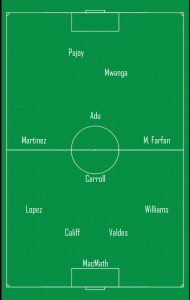
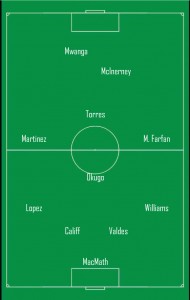
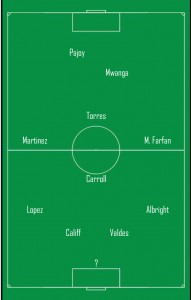
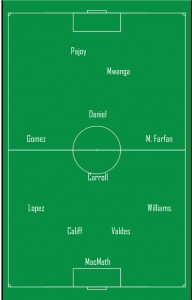
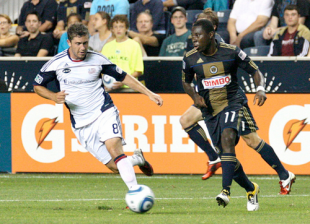

My only concern is the ability for Nowak to actually tell our wingers to play as wingers. We actually had natural wingers now like both Farfans and Khaliz but last season it never looked like we played true wingers.
Bravo sir. That is the fastest comment I have ever seen. The post published at 2:06 and you are johnny on the spot at 2:08.
Your concern, as we have all seen, is quite valid, but if we played with two physical strikers and a proper CAM, perhaps the wingers wouldnt be required to constantly cut into the center of the pitch.
Time will tell.
Very thoughtful article. I would add that the trouble spots from last year centered around where the offense was reloaded. Coming deep out of the back from the sides lulls everyone into a false sense of ball control. The offense should be reloaded on the wings at midfield, and players allowed to attack quickly and through the middle and wings. Barca reloads on the wing, out about 40 yards from the goal. With a more forward reloading of the offense, the running is worth something as you always have the other side under pressure. We spent minute after minute reloading out of the back and sideways last year, and the game scores reflected this ball Possession strategy. Honest pressure and full out attack from the wings will invigorate this team. The Union have the horses… Let’s overwhelm them with simple but forceful play!
Why does everybody and their mother have Carroll in over Gomez? What quality does Carroll have that Gomez doesn’t dominate him in other than passing?
Gomez is way better at passing than Carroll. Gomez is going to start, but it might be on the wing.
I don’t want to sound like a dickhead here, but I don’t know how else to express that this is article shows a fundamental lack of understanding of how the game is played. This isn’t FIFA 12 or Football Manager, and the formation you’re throwing all these names into like some sort of fantasy football team isn’t real. You can play a flat 442, you can play a 442 with a diamond, you can play a 4312, but you seem to have taken a standard 442 diamond or 4312 and pushed the shuttlers out wide and thats a formation that, frankly, doesn’t exist (and for good reason, what kind of lunatic would play with a completely open center midfield?)
Not quite sure where you’re getting your hostility. Michael Farfan is a player that loves to play possession and move the ball centrally. Josue Martinez is also a player with a middle of the park skill set. Just because the diagram shows them near the touchline does not mean that’s where they’d be expected to stay throughout the game. Especially with the discussion of overlapping fullbacks, the outside midfielders aren’t deployed to just make runs to the corner flag.
What are you talking about? the center midfield is well protected by two center midfielders. if you dont want the wingers on the wings then where do you want them? and if you dont think this is an actual formation then maybe you should go back to playing foosball and leave Peter Nowak alone so he can coach is soccer team
Huh?
Only one defensive center midfielder. Wingers have freedom to work inside or attack the wings.
What are you talking about?
There AREN’T any wingers in 442 diamond nor a 4312…that was roughly my point
The terms “winger” and “outside midfielder” are often used interchangeably these days, particularly in the U.S. Look at the diagrams above. The midfield has central midfielders and guys out on the flanks. Call them “wingers” or “outside midfielders” or by numbers — it doesn’t matter. It’s pretty clear what Eli’s talking about.
@Dan Walsh There are no guys on the flanks in a 4312/442 diamond. Again, this is my entire point. Whether you call players who play wide halfbacks, wide midfielders, wingers, its all irrelevant to this discussion because none of those positions exist in a 4312 or a 442 diamond. Width in these formations is nearly entirely reliant on the fullbacks..
Obviously its hard to illustrate on diagrams as small at these, but the absurdity of playing with two wide midfielders, an attacking midfielder and a defensive midfielder is quite apparent on an actual pitch..
Wingers/outside midfielders/wide midfielder/right midfield/left midfield/No. 7/No. 11/the two midfielders who aren’t the 2 most center midfielders, who play outside the two most centrally deployed midfielders, whether they’re standing on the touchline or 15 yards in from it — It’s all semantics. I get what you’re saying, B, but you’re missing the point — seemingly intentionally, to try to show someone up. So you can stop now. 🙂
Trust me: Every Philadelphia Union fan has heard of the concept of an attacking fullback filling space along the wings in a narrow 4-4-2 — something Eli referred to in the post above. See, there’s this guy, and his name is Sheanon Williams…
I like the 4-4-2 but honestly have serious doubts as to whether or not Torres or Adu can be dominant as a CAMs in the MLS (I would start Gomez instead)…also Nowak has an affinity to play two DMids againts better teams, something I dont see changing this year…as a whole the Union has improved vastly and should compete for the conference with the players on the squad…but can Nowak put it together or will he over think starting 11’s (Migs)?
Another good article, keep up the good work.
Your post (and the previous one looking at a 4-3-3) illustrates the vast potentiality of the 2012 Union team. However, given the coaches history, one has to assume we will see a lot of different starting lineups, and thus will struggle to find the consistency and chemistry you rightly say will be critical to the team starting strong.
I also hope Nowak allows the Costa Rican relationship time to develop on the left. I think the ability of the outside midfielders to partner well with the fullbacks has provided the most dividends offensively for this team in the past; and considering all the personnel permutations we should expect in the middle and up front, establishing two dynamic pairings on the flanks should be job #1 for Nowak.